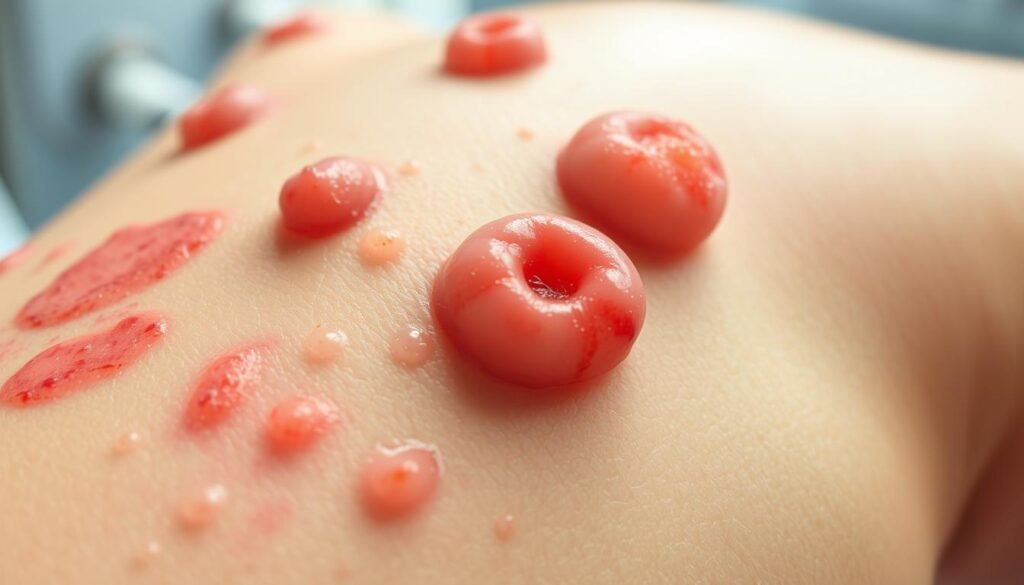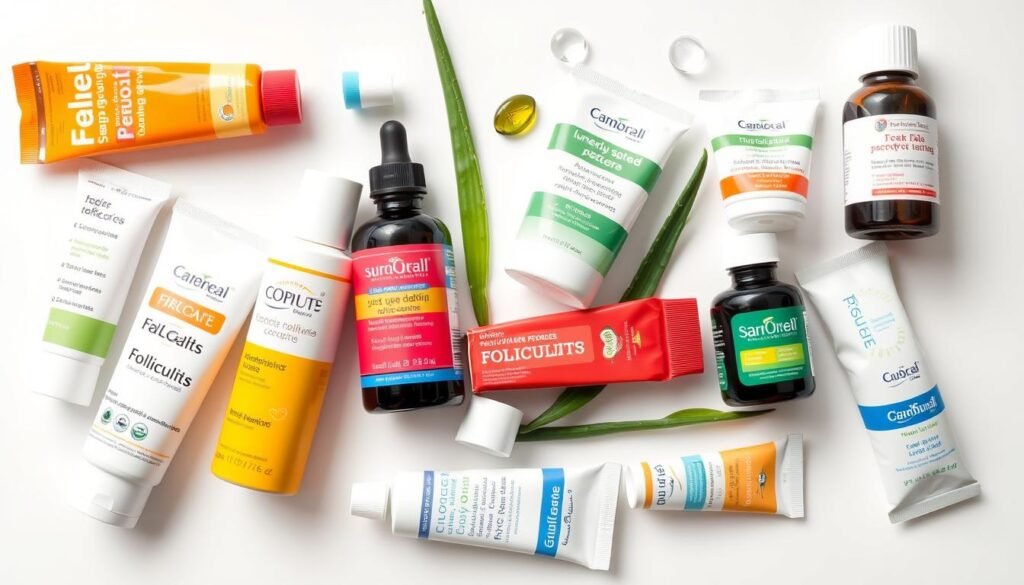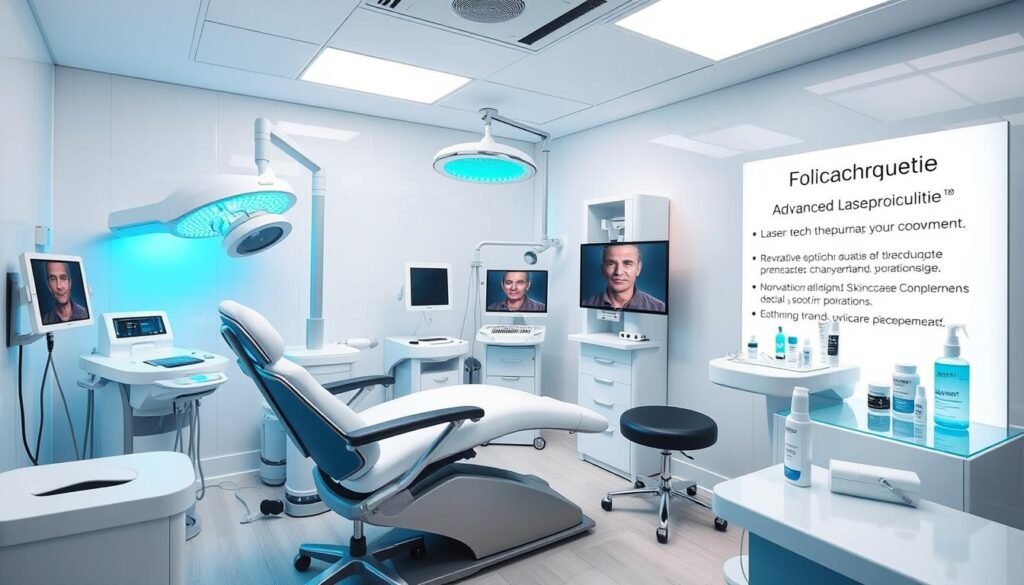Did you know over 80% of people will encounter skin folliculitis in their lives? This common issue involves inflamed hair follicles, leading to discomfort and sometimes shame. Knowing how to take care of folliculitis is key. It can get worse if not treated properly. This piece talks about the best treatments, including creams and pills. By looking into different ways to treat folliculitis, you’ll learn about effective solutions. These can soothe the skin and help it heal.
Key Takeaways
- Folliculitis can affect anyone, with over 80% experiencing it at some point.
- Medication options include topical antibiotics and oral medications.
- Self-care can significantly improve symptoms of folliculitis.
- Recognizing the type of folliculitis is essential for proper treatment.
- Consultation with a healthcare provider is recommended for severe cases.
Understanding Folliculitis
Folliculitis is a skin issue that causes inflammation of hair follicles. This can be quite uncomfortable, or even painful. It’s important to know about what is folliculitis including its causes, symptoms, and who is at risk. It often comes from infections – bacterial, fungal, or viral. These infections lead to itchy, pus-filled bumps on your skin. They may look red and have whiteheads in mild cases.
Anyone can get this folliculitis skin condition, from kids to adults. But, it hits harder if your immune system is weak. This could be due to diabetes or using antibiotics for a long time. Tiny mites and certain bacteria, like Staphylococcus aureus, are mainly to blame for the hair follicle inflammation.
Using hot tubs a lot, wearing tight clothes, or rough hair removal can up your chances of getting folliculitis. Some types can even spread, especially if caused by certain bacteria. Keeping clean is key to stop or handle this problem. Check out more in this article on folliculitis.
Types of Folliculitis
Folliculitis is a common skin problem that involves swollen hair follicles. It comes in many types, based on cause. Knowing the types of folliculitis helps manage and treat it better. The most seen type is bacterial folliculitis, mainly caused by Staphylococcus aureus bacteria. This leads to sore pimples that look like acne and affects people of all ages.
Hot tub folliculitis is another major kind. It happens after using poorly managed hot tubs, often appearing on the back and causing severe itch. The bacteria behind it, Pseudomonas aeruginosa, loves warm, moist places and can infect many swimmers.
Pseudofolliculitis barbae or razor bumps, often show up in the beard area or on legs after shaving. This issue mostly affects those with curly hair, leading to ingrown hairs. It’s a big problem for men who shave close or women shaving their legs.
Each folliculitis type needs its own way of treatment. For razor bumps, changing how you shave, using special razors, or considering laser removal might help. Knowing which type you have lets doctors suggest the best treatment, like antibacterial cleansers for bacterial ones or treatment steps for hot tub folliculitis. Learning about different types of folliculitis helps in dealing with these skin issues for better health.
| Type of Folliculitis | Common Cause | Typical Locations | Treatment Options |
|---|---|---|---|
| Bacterial Folliculitis | Staphylococcus aureus | General body areas, neck | Topical or oral antibiotics, antiseptics |
| Hot Tub Folliculitis | Pseudomonas aeruginosa | Back | Antiseptic washes, vinegar rinse |
| Pseudofolliculitis Barbae | Ingrown hairs | Beard area, legs | Change blades, laser hair removal |
Common Symptoms of Folliculitis
Folliculitis starts with an itchy rash that makes everyday life hard. You might see pus-filled bumps around hair roots. These bumps can hurt and are often found on the face, neck, and body.
Bacterial folliculitis is caused by Staphylococcus aureus bacteria. It creates itchy, pus-filled bump clusters. Hot tub rash comes from poorly maintained pools. It leads to round, itchy bumps that turn into blisters quickly.
Shaving can cause razor bumps because of ingrown hairs. Curly hair people often get painful, pus-filled bumps. Another issue, pityrosporum folliculitis, comes from yeast. It causes itchy, pus-filled spots mainly on the back and chest.
Long-term antibiotics can trigger gram-negative folliculitis. It shows as pus-filled bumps near the mouth and nose. Eosinophilic folliculitis affects HIV patients with severe itching. Sycosis barbae also causes painful, itchy clusters from shaving.
It’s crucial to notice folliculitis symptoms early. This helps manage the condition and prevent worse problems like scars or hair loss. Good skin care is key to avoiding these issues.
| Type of Folliculitis | Symptoms | Causes |
|---|---|---|
| Bacterial Folliculitis | Itchy rash, pus-filled bumps | Staphylococcus aureus |
| Hot Tub Rash | Round itchy bumps, pus-filled blisters | Pseudomonas bacteria in hot tubs |
| Razor Bumps | Painful, itchy bumps | Ingrown hairs from shaving |
| Pityrosporum Folliculitis | Itchy, pus-filled bumps | Yeast infection |
| Gram-Negative Folliculitis | Pus-filled bumps around mouth | Long-term antibiotic use |
| Eosinophilic Folliculitis | Intense itching, recurrent bumps | Unknown cause, affects HIV patients |
| Sycosis Barbae | Painful, itchy clusters | Shaving irritation |
Diagnosis of Folliculitis
A thorough medical check-up starts the folliculitis diagnosis process. The doctor looks over the skin and talks about the patient’s health history. This helps find any patterns or causes. Knowing the different types of folliculitis is key because they each have unique signs and causes.
If folliculitis doesn’t get better with first tries at treatment, more tests are needed. The doctor might take skin scrapings to look for yeast or other germs. A swab test can pinpoint bacterial reasons. In some cases, a skin biopsy is done to exclude other skin issues. It’s important for telling the difference between folliculitis caused by bacteria, viruses, or fungi.

Knowing what causes folliculitis is critical for treating it right. Research shows that weak immune systems, diabetes, and some drugs can make people more likely to get it. By testing for these factors, doctors can come up with a treatment plan that works better, helping patients heal faster.
Self-Care Strategies to Manage Folliculitis
Mild cases of folliculitis often get better with simple home care. Apply warm compresses to the sore area for 5 to 10 minutes several times a day. It helps ease itching and discomfort. This method soothes the skin and aids healing. Also, applying over-the-counter antibiotic ointments offers added support in treating folliculitis.
Keeping clean is key to recovery. Wash the affected area with antibacterial soaps to stop more outbreaks and reduce discomfort. Use soothing lotions to help calm irritated skin. If you have folliculitis, try not to shave the area. This can greatly cut down on irritation. If you need to shave, you might have to change how you shave to avoid ingrown hairs.
Using self-care measures regularly keeps skin healthy. Be gentle with your skin. Use anti-itch creams with hydrocortisone to control symptoms. If your skin doesn’t get better after a few days of home treatment, see a healthcare professional. They can check your condition and may prescribe medication.
Over-the-Counter Folliculitis Medication Options
People with folliculitis look for over-the-counter (OTC) meds to help with symptoms. These OTC options are great for handling mild inflammation caused by hair follicle issues. Popular choices include topical antibiotics and creams that fight inflammation.
Topical Antibiotics
Topical antibiotics, such as mupirocin and clindamycin, are widely used. They attack the bacterial infections behind folliculitis. Using these can lessen discomforts like soreness and itchiness. Many find that these treatments offer quick relief from mild bacterial folliculitis.
Anti-inflammatory Creams
Anti-inflammatory creams are another key option. They calm irritated skin and ease the pain folliculitis causes. By lowering inflammation, these creams help speed up recovery. Adding these creams to daily skincare routines can help manage symptoms early on.

Prescription Folliculitis Medication
When folliculitis gets severe or sticks around, seeing a healthcare provider helps. They might prescribe medication that tackles the root causes, like bacterial or fungal infections.
Oral Antibiotics
Oral antibiotics are key in fighting folliculitis’ bacterial infections. dicloxacillin and cephalexin are good at getting rid of the bacteria and cutting down swelling. Clindamycin is another common choice, meant to be used for 14 days. It’s applied three times a day, costing between $10.99 and $22.51 with a discount.
Choosing the right treatment is crucial for a proper recovery.
Antifungal Treatments
For folliculitis caused by fungi, doctors might suggest itraconazole or fluconazole. Fungal infections need a different treatment strategy. Mupirocin, used for 10 days and applied twice a day, starts at $10.99 at Costco with a card. Onexton, which mixes clindamycin with benzoyl peroxide, lasts for 14 days. It’s also used twice a day, starting at $20.75.
Getting the right diagnosis is important for picking the best medicine for folliculitis. It makes sure the main issue is addressed. Nowadays, you can also have online consultations for folliculitis treatments at affordable prices, starting at $15. This makes getting help easier for many.
| Medication | Duration | Application Frequency | Cost |
|---|---|---|---|
| Clindamycin | 14 days | 3 times a day | $10.99 – $22.51 |
| Mupirocin | 10 days | 2 times a day | Starting at $10.99 |
| Onexton | 14 days | 2 times a day | Starting at $20.75 |
For more detailed information on topical options and their effectiveness, one can explore topical antibiotics for scalp folliculitis.
Advanced Treatments for Severe Cases
For those suffering from severe folliculitis that doesn’t get better with standard treatments, looking into more advanced options can help. Minor surgery to drain large boils or carbuncles can reduce pain and help healing. This might give significant relief.
When folliculitis keeps coming back, laser hair removal for folliculitis might be a good choice. This method can stop the problem of pseudofolliculitis barbae, especially for people who get irritated from regular shaving. Removing hair follicles can lessen inflammation and irritation.
Treating severe folliculitis well means taking a thorough approach. This might include antibiotics made just for the person’s needs. It’s wise to talk to medical professionals for custom advice. They can suggest creams or more extensive treatments if necessary. For more information, check the Cochrane Review. It has lots of details on how to manage this skin problem.

| Treatment Option | Description | Effectiveness |
|---|---|---|
| Minor Surgical Intervention | Draining of large boils or carbuncles to relieve pressure and pain. | Generally effective for immediate relief. |
| Laser Hair Removal | Permanent hair removal technique to prevent inflammation and irritation. | Highly effective for pseudofolliculitis barbae. |
| Topical Antibiotics | Medications applied directly to the affected area. | Effective for mild to moderate cases. |
| Systemic Antibiotics | Oral medications for more severe infections. | Effective depending on bacterial resistance. |
Folliculitis Prevention Strategies
To prevent folliculitis, start with good hygiene practices and tweak your lifestyle. Avoid wearing tight clothes that can trap sweat. This prevents follicles from getting clogged. Also, make sure public pools you use are clean to reduce bacteria contact.
Shaving right is key to avoiding folliculitis. Always shave in the direction your hair grows. Use clean razors and keep your skin moisturized. Following these folliculitis prevention tips will lead to healthier skin and less irritation.
Know what triggers your folliculitis. Some medications or activities might increase the chance of getting it in sensitive areas. Keep your skin healthy by staying hydrated and eating well. This boosts your skin’s ability to fight off issues.
For more details on folliculitis and tips on preventing it, check out this informative link.
Conclusion
Folliculitis is a common skin issue affecting many people. Studies show almost everyone will face it at some point. Knowing the types and symptoms of folliculitis is key to treat it effectively. Depending on the condition’s severity, treatments vary from self-care to medications.
Good skin care is vital in handling folliculitis. For mild cases, home remedies are helpful. But, tougher cases may need a doctor’s care. Following a dermatologist’s advice and using the right treatments helps heal faster. It also lowers the chance of more outbreaks.
With proper knowledge and prevention, managing folliculitis becomes easier, leading to healthier skin and hair follicles. For more help on this topic, check out this resource on folliculitis diagnosis and.
